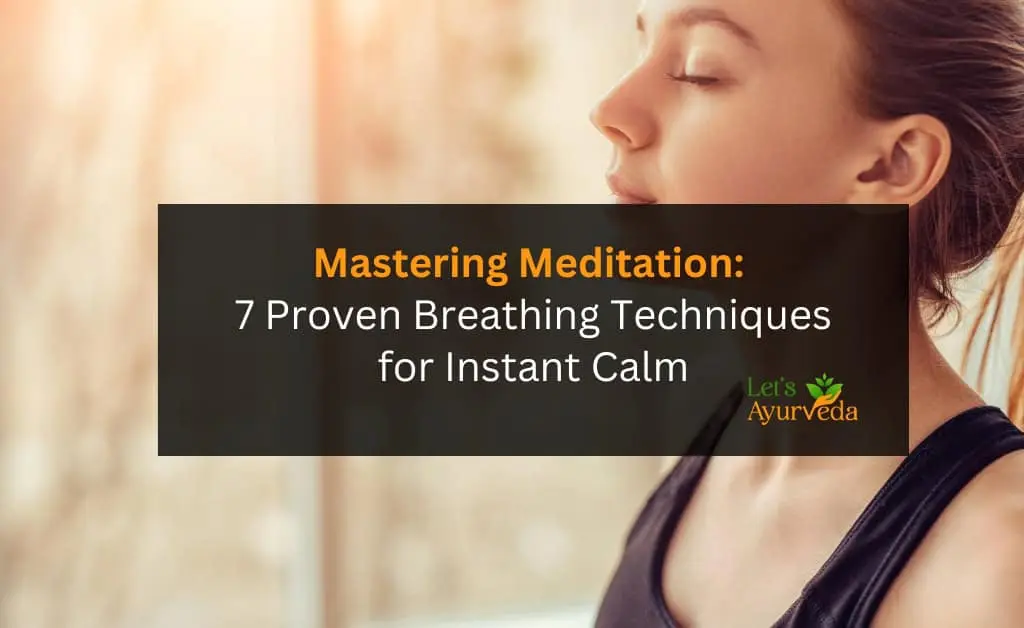It’s no surprise that when you sit down to meditate, your breathing feels shallow, erratic, or forced. Learning how to breathe correctly during meditation can make all the difference in your practice. In this guide, we’ll walk you through the essential techniques and science-backed tips to breathe properly while meditating, allowing you to relax, focus, and experience the full benefits.
Struggling with Meditation? Poor Breathing Could Be the Culprit
Many people approach meditation expecting instant calm and focus, but find themselves restless, distracted, or unable to focus on their breath. If this sounds familiar, you’re not alone. Improper breathing can lead to anxiety, frustration, and a lack of progress in your meditation journey. You might be wondering, "Why is meditation so much easier for others? What am I missing?"
How Poor Breathing Ruins Your Meditation Experience
Breathing is the foundation of meditation. If it’s out of sync, your mind follows. When you don’t breathe correctly, your body remains tense, your thoughts scatter, and you feel more stressed. Not only does poor breathing prevent you from reaching a meditative state, but it also diminishes the physical benefits, like reduced stress and lower blood pressure, that meditation offers.
But don’t worry—fixing this issue is simpler than you think. By mastering a few specific breathing techniques, you can take your meditation to the next level, ensuring you feel more grounded, present, and at peace.
7 Breathing Techniques for Effective Meditation
Now that we understand the problem, let’s dive into the solution: how to breathe properly during meditation. Below are seven key techniques that will help you stay calm, focused, and connected during your practice.
1. Abdominal Breathing (Diaphragmatic Breathing)
One of the most effective ways to breathe during meditation is through abdominal breathing, also known as diaphragmatic breathing. This technique involves using your diaphragm to breathe deeply into your belly, not your chest. It engages your parasympathetic nervous system, which triggers relaxation.
How to do it:
-
Find a comfortable seat with your back upright.
-
Place one hand on your belly and the other on your chest.
-
Take a deep breath in through your nose, letting your belly rise while keeping your chest steady.
-
Exhale through your nose and notice your belly fall.
This type of breathing helps you calm down, reduce stress, and focus more easily.
2. 4-7-8 Breathing Technique
Popularized by Dr. Andrew Weil, this technique helps bring your body into a state of deep relaxation. It’s great for those who find themselves feeling anxious or agitated during meditation.
How to do it:
-
Breathe in gently through your nose for a count of 4 seconds.
-
Hold your breath for 7 seconds.
-
Gently exhale through your mouth for 8 seconds, fully emptying your lungs.
-
Repeat the cycle at least four times.
The 4-7-8 breathing technique can calm your mind, reduce tension, and make meditation much smoother.
3. Box Breathing (Square Breathing)
Box breathing is a simple but powerful technique used by everyone from yogis to Navy SEALs. It involves inhaling, holding, exhaling, and holding your breath again—all for equal counts of time.
How to do it:
-
Inhale for 4 seconds.
-
Hold your breath for 4 seconds.
-
Exhale for 4 seconds.
-
Hold your breath again for 4 seconds.
Box breathing helps regulate your autonomic nervous system, promoting a sense of calm, clarity, and balance.
4. Nasal Breathing
Breathing through your nose is more beneficial than mouth breathing during meditation. According to studies, nasal breathing filters the air, slows the breathing rate, and increases nitric oxide levels, which improves lung capacity and oxygen absorption.
How to do it:
-
Close your eyes and gently breathe in through your nose.
-
Let the air flow naturally, focusing on the sensation as it moves through your nostrils.
-
Keep your exhalation longer than your inhalation to enhance relaxation.
Nasal breathing keeps you focused and helps you stay present during meditation.
5. Counting Breaths
If your mind tends to wander during meditation, counting breaths is an excellent way to stay focused. This technique is especially useful for beginners who find it difficult to maintain attention.
How to do it:
-
Inhale and mentally count "one."
-
Exhale and count "two."
-
Continue counting up to ten, then start over.
Counting your breaths not only enhances focus but also helps prevent your mind from getting lost in distractions.
6. Alternate Nostril Breathing (Nadi Shodhana)
This yogic breathing technique helps balance the energy in your body, calming both the mind and the nervous system. It's perfect for pre-meditation practices.
How to do it:
-
Close your right nostril by pressing your thumb against it.
-
Inhale deeply through your left nostril.
-
Close your left nostril with your ring finger, then breathe out through your right nostril.
-
Repeat the process, inhaling through the right nostril and exhaling through the left.
Alternate nostril breathing clears energy channels and balances your body, allowing for a deeper meditation experience.
7. Ujjayi Breath (Ocean Breath)
Ujjayi breath is a technique often used in yoga practice to build heat and focus. It creates a soothing sound, similar to ocean waves, which can be very grounding during meditation.
How to do it:
-
Inhale deeply through your nose.
-
As you exhale, gently constrict the back of your throat to make a soft hissing sound.
-
Keep your breath smooth and even, focusing on the sound as it leaves your body.
Ujjayi breath can help you stay present and mindful throughout your meditation practice.
The Science Behind Proper Breathing in Meditation
The way you breathe has a direct impact on your physical and mental well-being during meditation. According to Harvard Health Publishing, deep breathing techniques can lower cortisol levels, reduce blood pressure, and activate the relaxation response in your body. By engaging in proper breathing techniques, you optimize your meditation for both mind and body, making the practice more effective and enjoyable.
Benefits of Breathing Properly During Meditation
Breathing isn’t just a background function during meditation—it’s a tool to unlock deeper states of calm and awareness. Here are some key benefits of mastering breathing techniques in your meditation practice:
-
Reduces stress and anxiety: Proper breathing signals your body to relax, which helps reduce the release of stress hormones.
-
Enhances focus: Focusing on your breath during meditation can sharpen your concentration and prevent distractions.
-
Improves physical health: Deep breathing increases oxygen supply, which benefits your heart, brain, and other vital organs.
-
Boosts emotional balance: Breathing mindfully during meditation helps regulate your emotions, leading to greater emotional resilience.
Final Thoughts
Breathing properly during meditation is the key to unlocking its full potential. Whether you're new to meditation or a seasoned practitioner, mastering these breathing techniques will not only deepen your practice but also bring more peace and clarity to your life. Remember, it’s not about perfection—it’s about learning to breathe with awareness and intention.
So, take a deep breath and begin your journey toward a more mindful, relaxed you!






